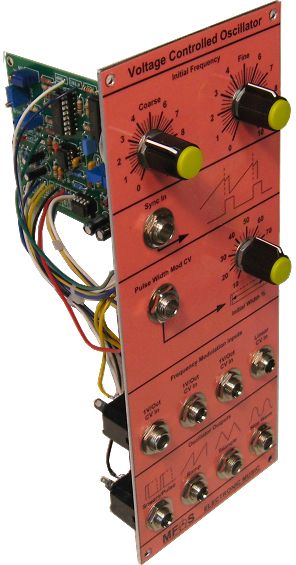Voltage Controlled Oscillator (Excellent 1V/Octave Tracking)
Ray Wilson authored this content while he was actively running MFOS as the founder and resident genius.
We retain the content because it reflects a valuable point of view representing that time and place.
Article by Ray Wilson
FOR HISTORICAL REFERENCE ONLY
This is an intermediate to
advanced project and I do not recommend it as a first project if you are just getting started in synths or electronics.
Only the circuit and some explanation are shown here. A lot of project building, troubleshooting and electronics
experience is assumed. Additionally, electronic equipment ownership (scope, meters, etc.) is taken for granted. If you
are interested in building this project please read the entire page before ordering PC boards to ensure that the
information provided is thorough enough for you to complete the project successfully.
Introduction
Oscillators are the main tone generating modules of your synthesizer.
This oscillator produces sine, square, triangle and ramp waveforms and with careful
adjustment tracks at 1V/octave over 6 to 8 octaves.
The parts for it are easily obtained and not extremely expensive. The whole circuit is here so breadboard it and see
if you like it. I like this oscillator but please recognize that it relies on a well matched pair of transistors.
Its frequency range is from below audible to beyond audible.
If this oscillator meets your needs I have high quality PC boards for sale for this design.
Voltage Controlled Oscillator Schematic Page 1 PDF
+/-15V Users Take Note
While helping diyer Doug Slocum improve the tracking on his MFOS VCOs I found a
few things +/-15V users should change.
- Change R46 to 1.54K metal film (1.5K carbon will be ok too).
This sets the bias for the comparator since it changes at +/-15V.
This corrects the whole rest of the waveform chain's amplitude.
- Change R10 to 150K and R65 to 43K this will give you a better range on the
coarse freq control. Use metal film.
- Change R28 to 1.5M metal film. Changes the starting current of the expo convertor to 1uA.
- Use OP275 for U1. Its performance is superior to other op amps.
- Make sure and use a 20K multi-turn for the high frequency adjust. 50K if you don't have enough range with 20K.
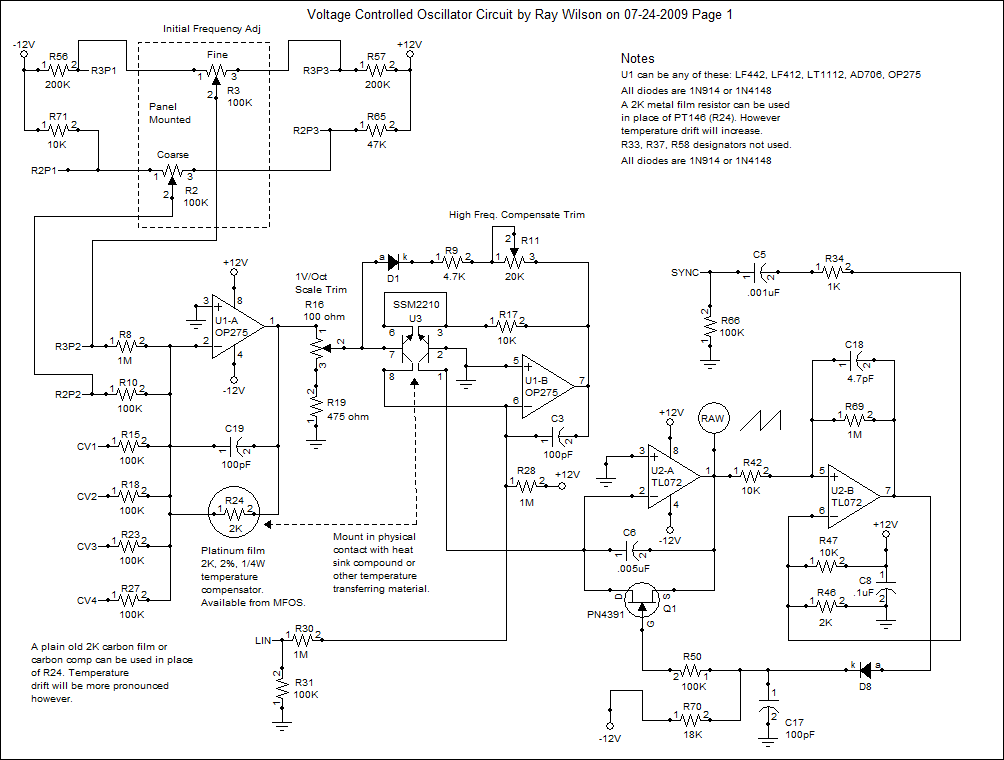
Page 1 shows the voltage to exponential current conversion and ramp generator circuitry. U1-A is the control voltage summer. It's output
feeds the scale trimmer R16 whose wiper is connected to the base of the current reference NPN transistor in the feedback loop of U1-B.
The CV summer (U1-A and associated components) with it's 2K feedback resistor and 100K input resistors has a gain of -1/50th or -.02.
Its purpose is to accept control voltages fed to its inputs and scale them to 20mV per volt of input. The trimmer R16 permits adjustment
to 18mV per volt which is what the base of the NPN in the SSM2210 at pins 8(c), 7(b) and 6(e) expects in order to convert the voltage
in an exponential manner. Linear changes in voltage applied to the CV1 through CV4 inputs of U1-A are converted to exponential
changes in current at the current sink (collector of NPN transistor at pins 1(c), 2(b) and 3(e) of the SSM2210 Super Matched NPN Pair IC).
For each additional volt of CV there is a doubling of the current flowing into pin 1 of U3.
The high frequency compensation circuitry D1, R9 and R11 allow the output of U1-B to boost the current at
the current sink at higher control voltage (and thus higher frequency) to make up for the finite time required to
discharge the integration capacitor C6 during oscillation. There is some interaction between the scale trimmer and the
high frequency compensation adjustment so expect to go back and forth a bit during calibration. I like to set R11 to minimum (wiper to pin 1)
and first calibrate with just R16. I adjust R11 when I see the frequency start to go flat at higher (greater than 4kHz) frequencies.
The current flowing into pin 1 of U3 causes the integrator made up of U2-A and C6 to ramp from ground toward V+.
The better the linearity of the op amp used for U2 the better the oscillator will track.
The ramping voltage on the output U2-A is fed into the comparator made up of U2-B and associated components.
As long as the ramping voltage is below the voltage on the non-inverting input of comparator U2-B (approximately 2V), U2-B's output stays at about -10.6 volts.
When the ramp voltage gets to about 2.2 volts U2-B's output shoots from about -10.6V to about 8V and forward biases D8, charges C17 and turns on
the PN4391 N channel JFET which resets the integrator (causes the output of U2-A to return to ground). The reset takes about 1uS after which the
output of U2-A again begins to ramp up linearly.
The output of U2-B when U2-A's output exceeds 2.2V is a very brief pulse (ALWAYS use the x10 setting on your scope probe to observe it)
that goes from -10.6V (op amp negative saturation voltage) to about 8V and then back to -V. It is about 3 uS in duration.
Thus the output of U2-A (point RAW) is a ramp wave that goes from ground to +2.2 volts. The ramp's frequency is determined by the
current flowing into pin 1 of U3. Since the current doubles for every increase in 1V applied to the CV summer the frequency doubles in kind.
When the current doubles the rate of the ramp generator doubles and thus the frequency of the ramp wave doubles.
This is the heart of the VCO (literally).
Applying a control voltage to the LIN input causes a linear shift in frequency as this input affects the reference current
in the exponentiator. Applying a square wave from another oscillator to the sync input causes the comparator to reset the
integrator (on the rising edges of the square wave) which produces interesting timbres when the outputs of the
oscillator providing the sync signal and the oscillator being synced are mixed. Panel mounted pots R2 and R3 provide the initial frequency (tuning)
adjustment. Detailed calibration instructions are in a section below. R16 and R11 should definitely be multi-turn cermet
type trim pots so you have fine resolution when adjusting the V/Oct scale and high frequency compensation.
These ideas were pioneered by the Alan Pearlmans, Bernie Hutchins, and Robert Moogs of the world I am merely
a student of their landmark work.
For best performance and least temperature drift use: 1% resistors throughout this portion of the circuitry, a
metal film 2K Ohm 1/4W +/-2% T.C. +3300 PPM tempco
for R24, and a silver mica
or polystyrene capacitor for C6. If you use the tempco for R24 you need to put it in direct thermal contact with the matched
transistor pair used in the linear voltage to exponential current convertor. The board is designed to accomodate a wide range
of transistors from matched pairs in 8 pin pacakages to two separate transistors.
You can substitute some of the parts as listed at the beginning of the parts list section below but the PN4391 and OP275 are highly recommended.
| Approx. Current Consumption |
| +12V | 28mA |
| -12V | 26mA |
Assume slightly higher for +/-15V
Voltage Controlled Oscillator Schematic Page 2 PDF
Wider Pulsewidth Adjustment Range
While putting together a few oscillators recently I changed R68 to 1M and got a much wider range of pulsewidth adjustment.
However, in the extreme settings (all the way up or all the way down) it could cause the pulse wave to cease output.
I don't mind this as it lets me set very narrow pulse widths.
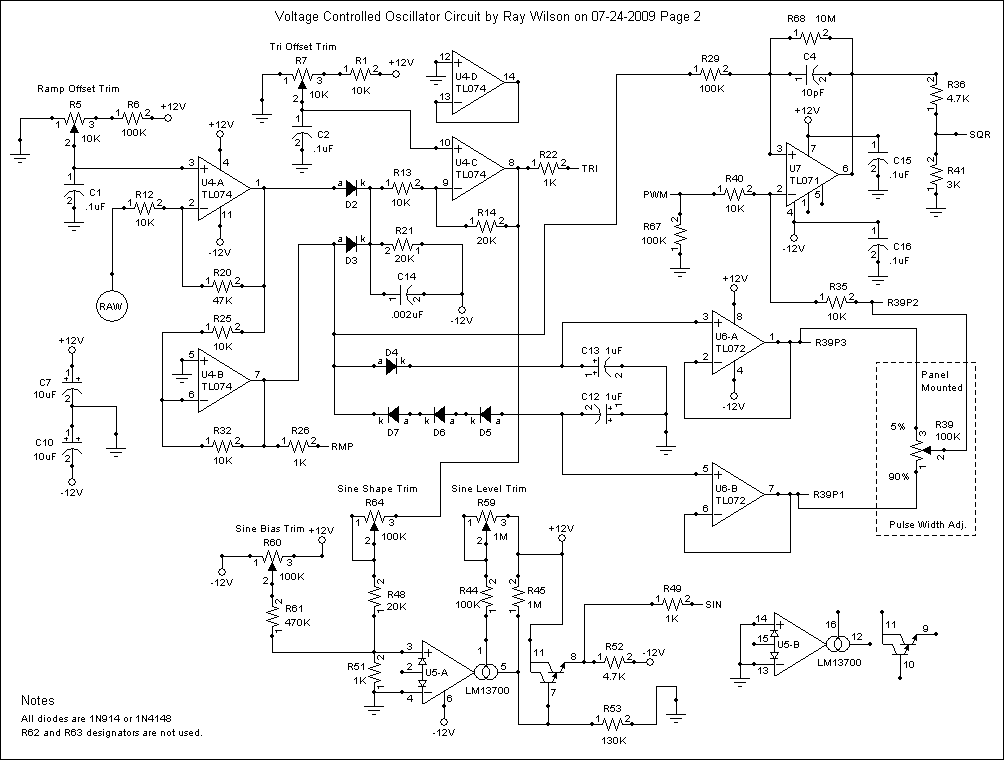
Page two shows the circuitry that converts the raw ramp wave into ramp, triangle, sine, and rectangle waveforms. RAW is applied
to inverting buffer U4-A where gain and offset are applied to the signal. The original 2.2 volt signal is boosted to about
10 volts P-to-P. Adjust R5 so that the sawtooth waveform at pin 1 of U4-A oscillates evenly about ground.

U4-A's output is fed to inverting unity gain buffer U4-B. The positive excursions of the outputs of
U4-A and U4-B are rectified by D2 and D3 and dropped across R21 (20K resistor to -12V) and fed to U4-C inverting buffer with a gain
of 2. This results in a triangular waveform at the output of U4-C
after the Saw Offset and
Tri Offset trims have been properly adjusted. As explained in the drawing this design produces inaudible glitches
at the time the integrator is reset by the comparator. This is because of the finite fall time of the integrator's
output. Even though the integrator's fall time is about 1 uS the output of U4-A after inversion and gain takes about
3 uS (due to slew rate limiting of the op amp) to go from low to high (remember its inverted).
U4-B takes about 3 uS to go low (its the original with x2 gain, again due to slew rate limitations). Thus a glitch
of about 6 uS takes place at the peak of the triangle wave. This glitch is so fast that in practice it
contains no audible information. C14 reduces the amplitude of the glitch by filtering the majority of it to -V.

The triangle waveform is fed into the circuit which uses the U5 (LM13700 or equivalent) to apply non-linear distortion which effectively
approximates a sine wave. R60 (Sine Bias Trim), R64 (Sine Shape Trim), and R59 (Sine Level Trim) are all used to
get the best sine shape possible. The figure below illustrates the effects of these pots on the waveform. Shaping
circuits are never perfect and in the end if you achieve 1% distortion figure you will be very happy. If you don't have a
distortion analyzer use your scope and your ears to determine the best sine shape. It is interesting to adjust the
waveform to where you believe it sounds best and then tweak a little. You will be suprised to see how little
distortion it takes to start adding overtones to the fundemental frequency. Adjust until you hear the purest
tone with the least overtones. Listen while sweeping the frequency with the coarse adjust knob as well. Again,
try to achieve the purest tone throughout the oscillators musical range.

In order to provide bias levels for the rectangle wave comparator I use the ramp wave which appears at the output
of U4-B. Note that the positive excursions forward bias D4 and charge C13. The negative excursions forward bias
D7, D6 and D5 and charge C12 negatively. We end up with ramp positive peak minus one diode drop on C13 and
ramp negative peak - 3 diode drops on C12. We buffer these voltages with U6-A and U6-B respectively and apply them to
the ends of R39 panel mounted Pulse Width Adjustment pot. The wiper of R39 provides continuous adjustment between these
two voltages and is connected to the inverting input of U7 (which is used as a comparator). When the voltage of the
ramp waveform applied to the non-inverting input via R29 goes above the threshold set by the pot the output
of U7 goes high. When the voltage of the ramp waveform applied to the non-inverting input via R29 goes below
the threshold set by the pot the output of U7 goes low. Thus you have pulse width adjustment of between approximately 10% to 90%
duty cycle for the rectangle wave's output. Voltage applied to the PWM input changes the threshold and thus provides
a means to "voltage control" the pulse width.
Voltage Controlled Oscillator Scale Calibration
After getting the waveforms adjusted properly you need to set the oscillator scale factor and high frequency compensation trim pots.
You will need a stable adjustable voltage source that can provide 0 through 10 volts, an accurate DVM, and a frequency counter.
You can use an oscilloscope instead of the frequency counter but the frequency counter is more accurate. Without a frequency
counter or scope you will need to use your ears.
The following process is iterative and can be tedious. If you have a keyboard controller or MIDI to CV convertot that puts out
1V/octave I find it is easier to simply play octaves on the keyboard and trim the scale factor and high frequency compensator until
I get the correct 1V/octave response.
- Adjust the waveforms properly as described above.
- Connect the square wave output to your frequency counter.
- (Optional) Connect the sine wave output to an amplifier to listen as you go.
- Adjust R11 so that you have the most resistance between its pin 2 and pin 3
and thus the least high frequency pitch correction. We will adjust this later as necessary.
- Apply an adjustable voltage source to one of the 1V/Oct CV inputs.
- ITERATION POINT A
- Set the adjustable voltage source connected to the 1V/Oct CV input up to 0.000 volts.
- Adjust R2 and R3 so that the oscillator frequency is 100 Hz.
- Set the adjustable voltage source connected to the 1V/Oct CV input up to 3.000 volts.
- Observe the new frequency (which should be 800 Hz).
- If the observed frequency is 800 hz continue to "ITERATION POINT B"
- If the observed frequency is higher adjust R16 (Scale Adjust Trimmer) to cause the frequency
to go higher. If the observed frequency is lower adjust R16 (Scale Adjust Trimmer) to cause the frequency
to go lower. Repeat from "ITERATION POINT A"
- ITERATION POINT B
- Set the adjustable voltage source connected to the 1V/Oct CV input up to 3.000 volts.
- Adjust R2 and R3 so that the oscillator frequency is 800 Hz.
- Set the adjustable voltage source connected to the 1V/Oct CV input up to 6.000 volts.
- Observe the new frequency (which should be 6400 Hz).
- If the observed frequency is 6400 hz continue to "CALIBRATION COMPLETE"
- If the observed frequency is flat adjust R11 to cause the frequency to
go to 6400 Hz.
- CALIBRATION COMPLETE
Voltage Controlled Oscillator PC Board Drawings and Photos
Alternate placement of R24 When using a PT094 (or equivalent) tempco
|
Notice that there is a legend for R24 but there are also two alternate mounting holes on the board specifically for
mounting a metal film 2K Ohm 1/4W +/-2% T.C. +3300 PPM tempco as R24 so that it is in thermal contact with U3 (or matched discrete transistor pair).
Use thermal grease or epoxy to make the thermal contact. The tempco can go above a dual transistor package or 2 discrete transistors.
IMPORTANT INFORMATION! You should only install one of the resistors. If you use the tempco
for R24 in the alternate mounting then DO NOT MOUNT THE REGULAR R24 RESISTOR. Otherwise your oscillator scaling will be off by a
factor of 2 (i.e. an octave will span 2 keyboard octaves).
|
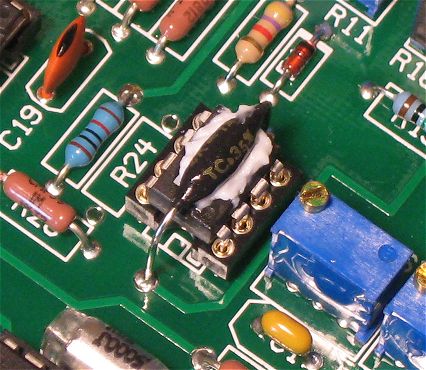
|
Populated VCO board. (Click for a larger view.)
Notice that R24 (regular resistor or tempco) is not mounted yet. The two holes on either side of the SSM2210 are for mounting the
tempco in contact with the SSM2210. Do not mount the regular R24 if you use it. Either use one or the other never both.
!!! NOTICE !!! In my opinion multi-turn trimmers are absolutely necessary for R11 and R16.
However if you use side adjust single turn trim pots for any of the other trimmers (R5, R7, R59, R60 and/or R64)
make sure you orient them so that you can adjust them without difficulty.
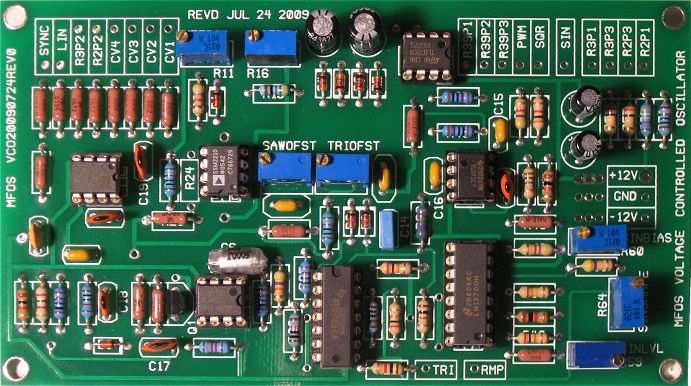
Voltage Controlled Oscillator Component Designator View
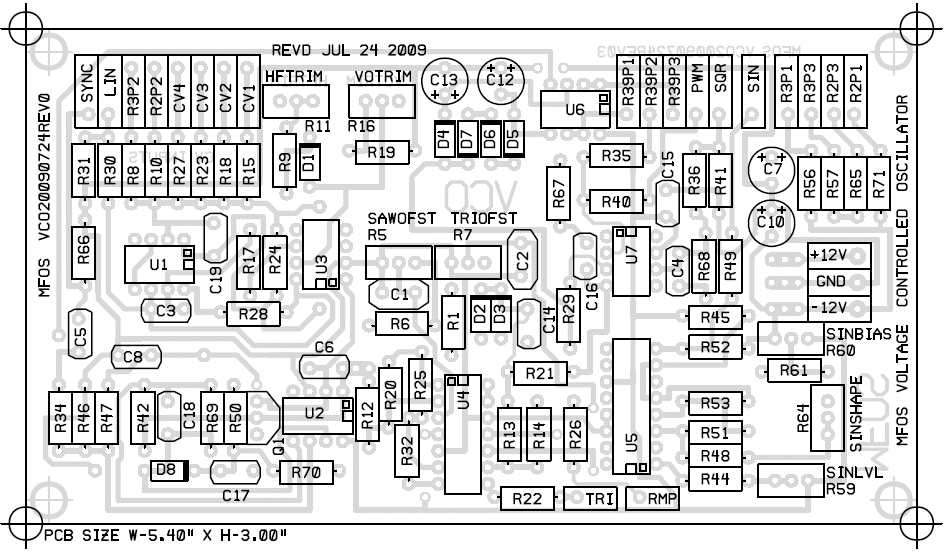
Voltage Controlled Oscillator Component Value View
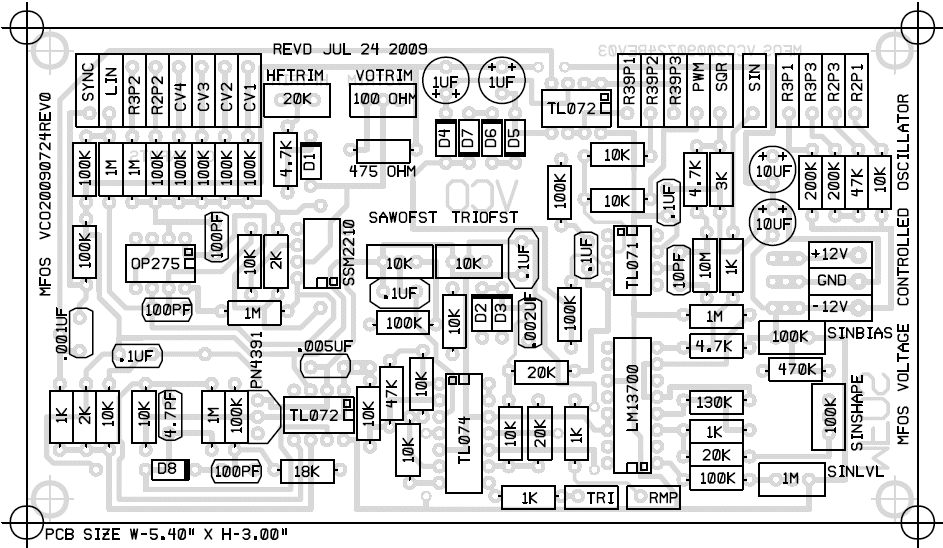
Voltage Controlled Oscillator PCB Bottom Copper (Parts Side View Shown)
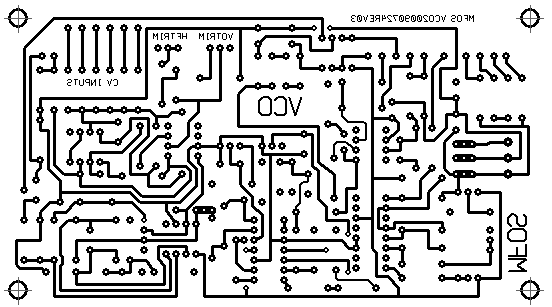
Voltage Controlled Oscillator PCB Top Copper(Parts Side View Shown)

Voltage Controlled Oscillator PCB Silk Screen(Parts Side View Shown)
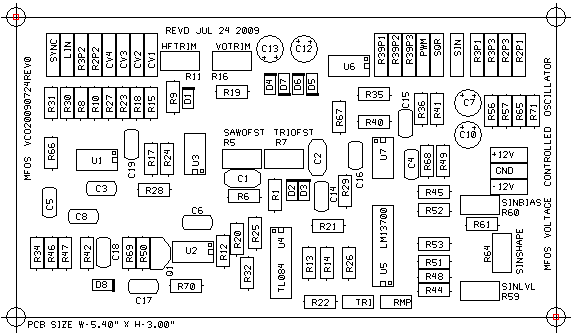
Voltage Controlled Oscillator Front Panel Drawings and Wiring
Voltage Controlled Oscillator Front Panel PDF
|
This overlay fits the UNIVERSAL panels I sell. I used a UNIVERSAL panel and two brackets when constructing my VCO.
|
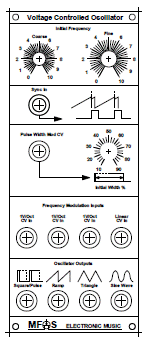
|
Dave Kronemeyer took the time to make a nice Front Panel Express design and share it
with all of us. If you use it make sure you take into account any differences related to the
wiring diagram.
|
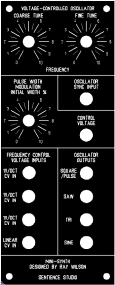
Click image to download .FPD File (Front Panel Express) File |
David Kronemeyer did a nice Front Panel Express layout.
Visit Front Panel Express
Click the image to download the .FPD File.
|
|
Voltage Controlled Oscillator Back Panel PDF
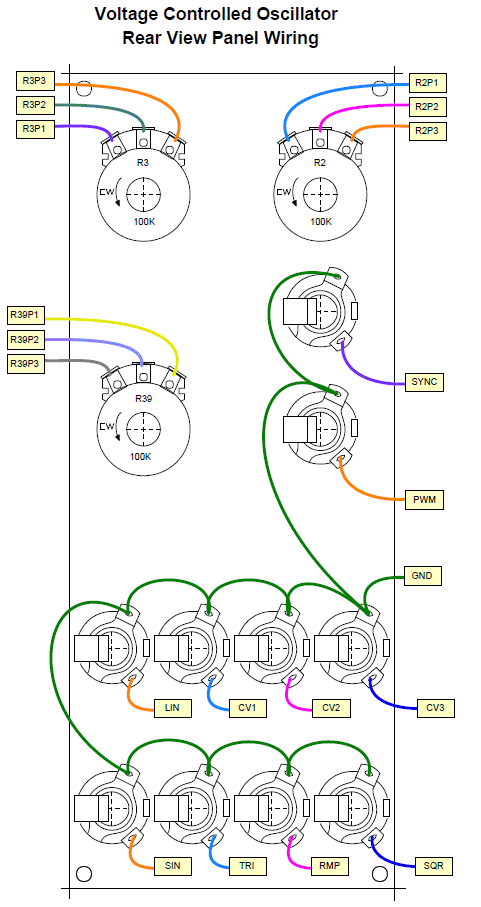
Voltage Controlled Oscillator Project Parts List
Order enough DIP sockets for ALL chips. Sockets are your friends!
Capacitor voltage rating should be 25V or greater for all capacitors.
Non-electrolytic capacitors can be film or ceramic type.
The integrator cap (C6 .005uF) needs to be temperature stable
so buy silvered mica, polystyrene or polycarbonate.
Substitutions
OP275 - LT1112, AD706, LF442, TL072
AD SSM-2210 - LM394 DIP or Two matched transistors (specs similar to 2N3904)
R24 (metal film 2K Ohm 1/4W +/-2% T.C. +3300 PPM tempco) - 2K Carbon Comp Resistor (provides no temperature compensation)
LM13700 - LM13600, NE5517, AU5517, NTE870, NJM13600D
TL074 - Any quad JFET op amp
PN4391 - 2N5457, J210, NTE457
Resistor Types & Tolerances
I suggest using 1% metal film for all resistors shown on page 1 of the schematic.
Using 1% metal film for all resistors shown on page 2 of the schematic except for R68 (10M) and R22, R26, R34, R49, R51 (1Ks)
will give greater uniformity of operation among multiple VCOs and better temperature tolerance but 5% carbon film resistors can be used as well.
| Qty. | Description | Value | Designators |
|---|
| 1 | LM13700 Dual gm OpAmp | LM13700 | U5 |
| 1 | OP275 Dual BiFET Op Amp | OP275 | U1 |
| 1 | SSM2210 Matched NPN Pair | SSM2210 | U3 |
| 1 | TL071 Op Amp | TL071 | U7 |
| 2 | TL072 Dual Op Amp | TL072 | U2, U6 |
| 1 | TL074 Quad Op Amp | TL074 | U4 |
| 1 | PN4391 N Channel JFET | PN4391 | Q1 |
| 8 | High Speed Switching Diode | 1N914 | D1, D2, D3, D4, D5, D6, D7, D8 |
| 3 | Linear Taper Potentiometer | 100K | R2, R3, R39 |
| 2 | Metal Film 1/4 Watt 1% Resistor | 2K | R24, R46 |
| 2 | Metal Film 1/4 Watt 1% Resistor | 47K | R20, R65 |
| 1 | Metal Film 1/4 Watt 1% Resistor | 475 ohm | R19 |
| 1 | Metal Film 1/4 Watt 1% Resistor | 470K | R61 |
| 3 | Metal Film 1/4 Watt 1% Resistor | 4.7K | R9, R36, R52 |
| 1 | Metal Film 1/4 Watt 1% Resistor | 3K | R41 |
| 12 | Metal Film 1/4 Watt 1% Resistor | 100K | R6, R10, R15, R18, R23, R27, R29, R31, R44, R50, R66, R67 |
| 11 | Metal Film 1/4 Watt 1% Resistor | 10K | R1, R12, R13, R17, R25, R32, R35, R40, R42, R47, R71 |
| 1 | Carbon Film 1/4 Watt 5% Resistor | 10M | R68 |
| 1 | Metal Film 1/4 Watt 1% Resistor | 130K | R53 |
| 1 | Metal Film 1/4 Watt 1% Resistor | 18K | R70 |
| 5 | Carbon Film 1/4 Watt 5% Resistor | 1K | R22, R26, R34, R49, R51 |
| 5 | Metal Film 1/4 Watt 1% Resistor | 1M | R8, R28, R30, R45, R69 |
| 2 | Metal Film 1/4 Watt 1% Resistor | 200K | R56, R57 |
| 3 | Metal Film 1/4 Watt 1% Resistor | 20K | R14, R21, R48 |
| 1 | Trim Pot 10 Turn | 20K | R11 |
| 1 | Trim Pot 10 Turn | 100 ohm | R16 |
| 2 | Trim Pot 10 Turn | 100K | R60, R64 |
| 2 | Trim Pot 10 Turn | 10K | R5, R7 |
| 1 | Trim Pot 10 Turn | 1M | R59 |
| 1 | Ceramic Capacitor | 10pF | C4 |
| 3 | Ceramic Capacitor | 100pF | C3, C17, C19 |
| 5 | Ceramic Capacitor | .1uF | C1, C2, C8, C15, C16 |
| 1 | Ceramic Capacitor | .002uF | C14 |
| 1 | Ceramic Capacitor | 4.7pF | C18 |
| 1 | Ceramic Capacitor | .001uF | C5 |
| 2 | Electrolytic Capacitor | 10uF 25V | C7, C10 |
| 1 | Silvered Mica Cap | .005uF | C6 |
| 2 | Tantalum Capacitor | 1uF 25V | C12, C13 |
Miscellaneous
- (1) 4" x 10" 1/16" thick Aluminum plate for mounting the pots and switches.
- Unit is typically mounted in a synth case with other synth modules.
- Assorted hardware 1" 6-32 nuts and bolts, 1/2" #8 wood screws, etc
- Knobs for potentiometers, wire, solder and typical assorted electronics hand tools.
- Digital Volt Meter and a Signal Tracer or oscilloscope for testing.
